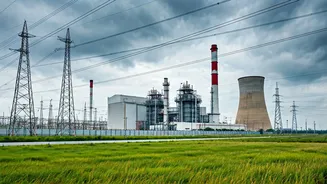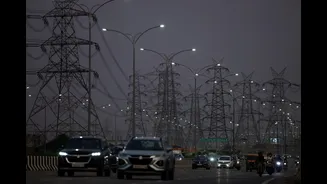October's Power Downturn
In October, India faced a notable reduction in its power output, marking the most substantial decrease observed since the onset of the COVID-19 pandemic.
This decline was primarily influenced by a significant decrease in power demand across the country. The period's extensive rainfall played a crucial role in lowering the overall energy consumption. This shift highlighted the sensitivity of the power sector to seasonal weather patterns. The dampening effect of the monsoon season significantly curtailed the requirements for electricity in various sectors, contributing to the downward trend. Furthermore, a combination of factors, including reduced industrial activity and changes in consumer behavior, likely contributed to this notable decline in power output, indicating a complex interplay of influences shaping the energy landscape of India during this period.
Rain's Impact on Demand
The monsoon season's influence was particularly evident in the considerable decline in power demand. Reduced requirements for air conditioning, lighting, and other electricity-dependent appliances during the rainy season led to lower overall consumption. This seasonal reduction had a noticeable impact on the power sector's operational dynamics. The agriculture sector, a significant consumer of electricity, also saw a dip in demand due to the reduced need for irrigation as the fields were well-watered by the rains. The shift in weather patterns caused a chain reaction, which decreased the overall energy needs across different segments of the economy. The power plants experienced a decrease in their production volumes to match this lower demand, thereby, signifying the strong interplay between weather and energy consumption in India during the specified month.
Factors Behind The Drop
Several contributing factors, beyond the influence of rainfall, played a role in the decrease in power output during October. Reduced industrial activity may have contributed significantly to lowering energy requirements. The manufacturing and production sectors, known for high electricity consumption, could have experienced a slowdown. Changes in consumer behavior also played a part as the general populace scaled down their use of electricity. The economic conditions prevailing at the time also influenced energy consumption. Moreover, factors such as maintenance activities in power plants might have temporarily reduced electricity generation capacity. Overall, the reduction in power output was caused by a combination of weather-related impacts, economic conditions, industrial activity and modifications to consumer behavior, together marking a complex scenario that shaped energy use during the specific month.
A Broader Perspective
This decline in power output offers a glimpse into the seasonal variability affecting India's energy landscape. It underscores the importance of anticipating and adjusting to the changes in demand influenced by weather patterns. The power sector needs to develop strategies that are effective for seasonal adjustments. These insights are essential for formulating efficient energy policies, optimizing resource allocation, and ensuring a stable power supply. Furthermore, it highlights the significance of diversifying energy sources and embracing flexible grids to efficiently meet the fluctuating demands. The event provides a lesson to learn from, emphasizing the necessity for an adaptable and resilient power sector that can effectively manage its operation against external influences.















